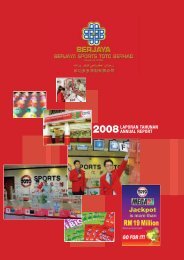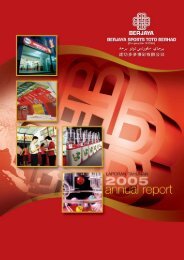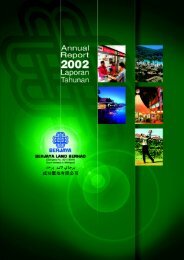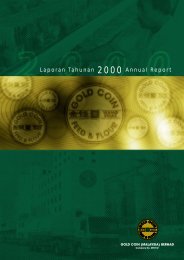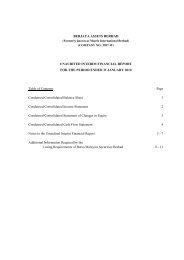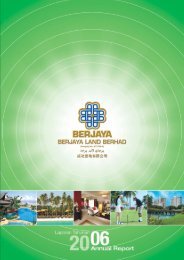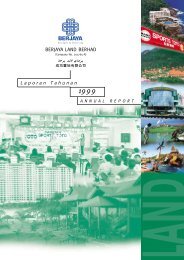Pg 147 - Berjaya Corporation Berhad
Pg 147 - Berjaya Corporation Berhad
Pg 147 - Berjaya Corporation Berhad
Create successful ePaper yourself
Turn your PDF publications into a flip-book with our unique Google optimized e-Paper software.
<strong>Berjaya</strong> Land <strong>Berhad</strong> (201765-A)<br />
Annual Report 2005<br />
51<br />
2 SIGNIFICANT ACCOUNTING POLICIES (CONT’D)<br />
(f)<br />
Land Held for Development and Property Development Costs (Cont’d)<br />
(ii) Property development costs (Cont’d)<br />
The excess of revenue recognised in the income statement over billings to purchasers is classified as accrued billings within<br />
receivables and the excess of billings to purchasers over revenue recognition in the income statement is classified as<br />
progress billings within payables.<br />
The adoption of MASB 32: Property Development Activities has not given rise to any adjustments to the opening balances of<br />
retained profits of the prior and current years. Comparatives, however, have been restated, as disclosed in Note 42 to the<br />
financial statements to conform to changes in presentation required by MASB 32 that have been applied retrospectively.<br />
(g) Investments in Subsidiary and Associated Companies<br />
The Company’s investments in subsidiary and associated companies are stated at cost less impairment losses.<br />
(h) Intangible Assets<br />
Goodwill on consolidation represents the difference between the purchase price over the fair value of the net assets of the<br />
investment in subsidiary and associated companies at the date of acquisition less proportionate amounts written off for subsequent<br />
disposals of these investments. Positive goodwill is retained in the consolidated balance sheet at cost less impairment losses.<br />
Negative goodwill is shown as a deduction from the positive goodwill on consolidation of the Group.<br />
Goodwill arising on the acquisition of subsidiary companies is presented separately in the balance sheet while goodwill arising on<br />
the acquisition of associated companies and jointly controlled entities is included within the carrying amount of investments in<br />
associated companies and investments in jointly controlled entities respectively.<br />
Goodwill or negative goodwill is not amortised. Goodwill is reviewed at each balance sheet date and will be written down for<br />
impairment when it is considered necessary.<br />
(i)<br />
Inventories<br />
Inventories comprise stores and consumables which are stated at the lower of cost and net realisable value. Cost is determined<br />
on a first-in-first-out basis.<br />
Property inventories are stated at the lower of cost and net realisable value. Cost includes the relevant cost of land, development<br />
expenditure and related interest cost incurred during the development period.<br />
Net realisable value represents the estimated selling price less all estimated costs to be incurred in marketing, selling and<br />
distribution.<br />
(j)<br />
Leases<br />
(i) Finance leases and hire purchase arrangements<br />
Assets acquired by way of hire purchase or finance leases are stated at an amount equal to the lower of their fair values and<br />
the present value of the minimum lease payments at the inception of the leases, less accumulated depreciation and impairment<br />
loss. The corresponding liability is included in the balance sheet as liabilities. In calculating the present value of the minimum<br />
lease payments, the discount factor used is the interest rate implicit in the lease, when it is practical to determine; otherwise,<br />
the Company’s incremental borrowing rate is used. Lease payments are apportioned between the finance costs and the<br />
reduction of the outstanding liability. Finance costs, which represent the difference between the total leasing commitments and<br />
the fair value of the assets acquired, are recognised as an expense in the income statement over the term of the relevant lease<br />
so as to produce a constant periodic rate of charge on the remaining balance of the obligations for each accounting period. The<br />
depreciation policy for leased assets is similar with that for depreciable property, plant and equipment as described in Note<br />
2(d).<br />
(ii)<br />
Operating leases<br />
Operating leases are leases other than finance lease. Lease rental under operating lease is charged to income statement on<br />
a straight-line basis over the term of the relevant lease.



